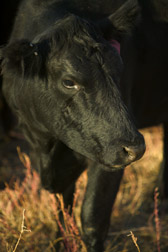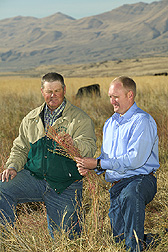This page has been archived and is being provided for reference purposes only. The page is no longer being updated, and therefore, links on the page may be invalid.
Read the magazine story to find out more. |
|
Snowy Pastures' Hidden Treat: Forage Kochia
By Marcia WoodJanuary 11, 2006
|
When snows blanket rangelands of the western United States, seeds, leaves and stems of a winter-hardy plant called forage kochia (KO-chuh) make an especially welcome, protein-rich treat for hungry animals. The shrub like plant nourishes not just cattle but sheep, deer, elk and antelope.
Having a new, taller forage kochia that could poke through the snowdrifts for easier reach would definitely help animals during the harsh winter months, according to Agricultural Research Service (ARS) plant geneticist Blair L. Waldron. That's why he's studying taller-growing forage kochia plants from Kazakhstan and other parts of Eurasia that might be used as parents for tomorrow's plants.
The only kind of forage kochia sold in the United States today--a plant called Immigrant--generally grows no more than two feet high, whereas Eurasian specimens apparently can reach five feet.
Waldron, based at the ARS Forage and Range Research Laboratory in Logan, Utah, collaborated with Utah State University animal scientists in a recent study that provides new details about forage kochia's ability to keep cattle--and ranchers' balance sheets--in good health.
For the test, 42 pregnant Angus cows spent early November through late January in either corrals, where they were fed alfalfa hay, or in pastures of forage kochia and crested wheatgrass.
At study's end, two indicators of overall health--body condition and backfat--were within the desirable range for all animals. Although backfat measurements were lower for cows that grazed on pasture, these animals were nonetheless in excellent condition for calving.
What's more, their feed costs were 25 percent less than their alfalfa-fed counterparts.
Planting forage kochia isn't a new idea for the intermountain West--the region that extends from eastern Oregon and Washington through Nevada, Idaho, Utah and Colorado to northern Arizona and New Mexico.
But the high cost of alfalfa hay, and the increased competition for water to irrigate it, are leading ranchers to take a new look at forage kochia.
Read more about the research in the January 2006 issue of Agricultural Research magazine.
ARS is the U.S. Department of Agriculture's chief scientific research agency.


